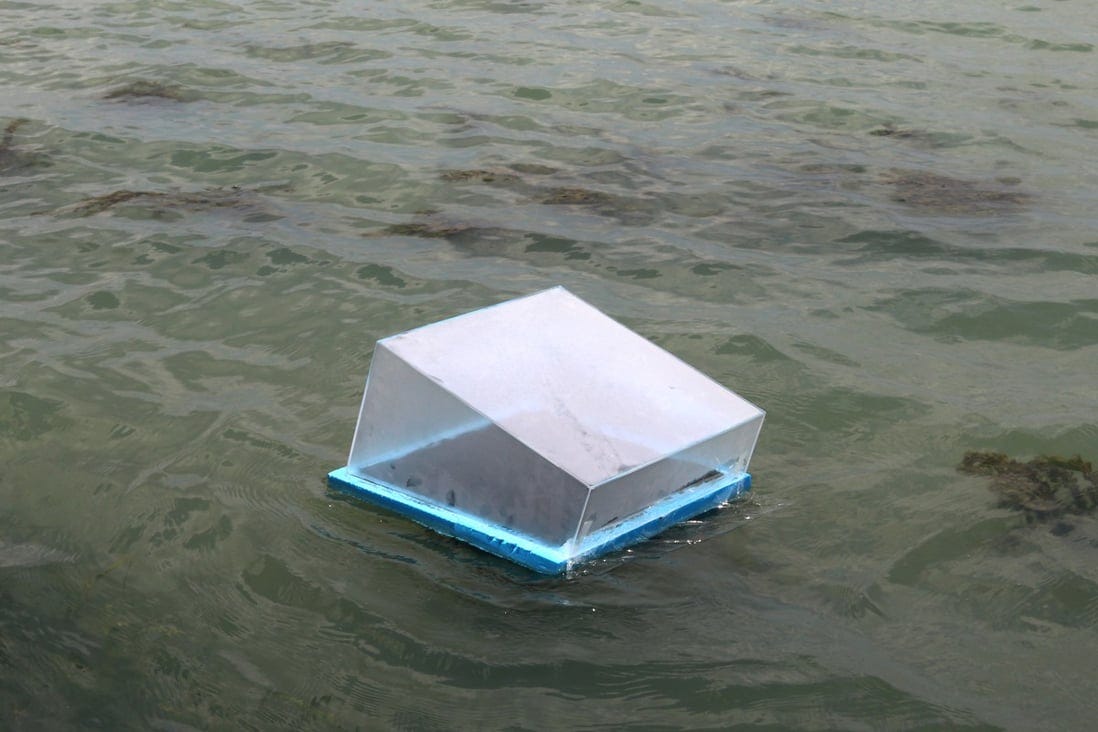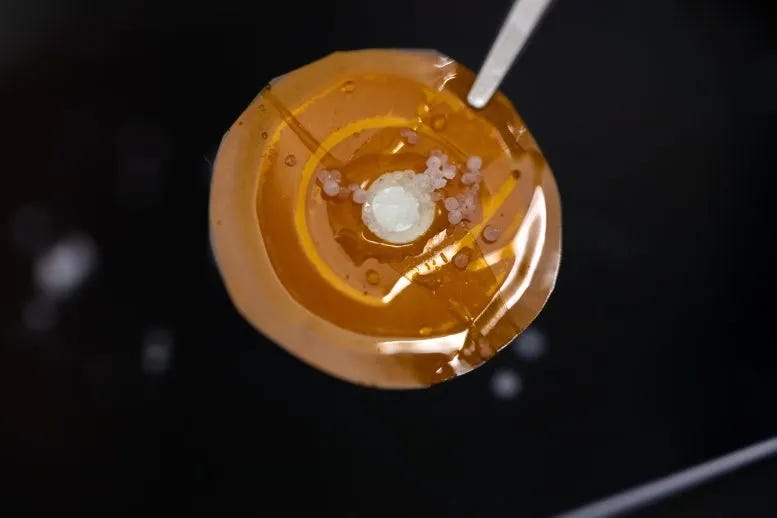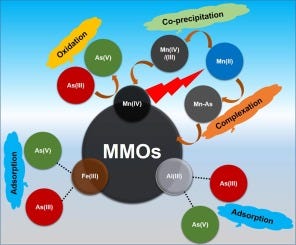#149 - Genki Balls, Beavers, Wastewater purity(?), Air Bubbles, 2D membranes and more
Water Water Everywhere...
Dear Readers,
This week we have some innovations & a whole lot of news from the world of water. As always do share your thoughts, like, share and subscribe!
Solar powered water purifier with a kicker - it can produce power
A research team from the Chinese Academy of Sciences’s Suzhou Institute of Nano-Tech and Nano-Bionics in China, has developed a solar-powered water purifier that can also generate a small but steady supply of electricity. The device works on the principle of a solar evaporator. A dark surface absorbs the solar energy as heat, the surface below that absorbs water which is then heated to evaporation. The water vapor leaves behind impurities, and salts rise up to the clear canopy. The canopy or umbrella over the dark surface serves to condense the water vapor where it flows out and is collected as clean water.
The limitation of such evaporators has been the accumulation of removed salts and solids on the condensation surface which in turn clogs or reduces the efficiency of the system. Their solution? - countless tiny micro-scale channels and nano-scale branches on the inside of the canopy, into which they added chemicals that can selectively remove ions in foul water, and at the same time prevent salt from crystallizing in the channels. The research team tested a prototype with a 30cm (1 foot) canopy at Dushu lake in Suzhou, Jiangsu province, and found it removed all detectable impurities from a water sample containing solid matter and living microorganisms.
The kicker - As water is evaporated and purified by the device, the continuous evaporation enriches positively charged ions on the canopy through those internal channels, generating a usable voltage in a phenomenon known as the hydrovoltaic effect. This can be used to power the devices purification during the night or to charge a battery for other uses!
2-D Membrane to desalinate at a nanoscale
Sticking with nanochannels, a research team led by King Abdullah University of Science & Technology (KAUST) has shown how ultrathin polymer-based ordered membranes can efficiently remove salt from brine and seawater, offering a potential alternative for current desalination systems. Their solution uses two-dimensional porous carbonaceous membranes with regular and uniformly distributed subnanometer-sized molecular transport channels. This 2-D membrane was built up using a technique from the semiconductor world known as chemical vapor deposition.
The researchers deposited the monomer triethynylbenzene on atomically flat single-crystalline copper substrates in the presence of an organic base that acts as a catalyst. Triethynylbenzene bears three reactive groups that serve as anchor points for additional monomers. These groups show a 120-degree angle with respect to each other, generating organized arrays of well-defined cyclic structures that stack into subnanometer-sized rhombic hydrophobic channels. These channels help separate the water from the impurities thereby functioning like a membrane filter at a nano-scale. They go on to say that the membrane displayed excellent water desalination performance in forward and reverse osmosis configurations, surpassing those containing advanced materials such as carbon nanotubes and graphene.
Air Bubbles to do PFAS cleaning
An Australian company has come up with a method to remove PFAS from water. Called Surface Activated Foam Fractionation (SAFF) this method uses rising columns of bubbles to separate the PFAS molecules from a liquid solution. The bubbles with PFAS form a foam or froth layer at the top of the column, which is then harvested from the solution and concentrated over multiple stages to make it ready for destruction.
First Foam fractionation is used to separate the PFAS molecules from water. Then in the next two stages, Foam fractionation continues to de-water the PFAS molecules and creates a PFAS rich hyper-concentrate, achieving concentration rates of up to 3.5 million times. Finally this concentrated PFAS foam is destroyed by pairing with other destruction technologies, such as electrochemical oxidation, super-critical water oxidation, reductive defluorination or cold plasma.
Low-cost Arsenic removal for the developing world
Large swathes of Eastern India have a problem with arsenic contaminating groundwater. Removing this known carcinogen is expensive and as such not an accessible solution for Indians in rural or semi-rural settings. Having grown up seeing this problem first hand, a professor and his team from IIT-Roorkee developed a novel mechanism that will absorb two of the most hazardous arsenic species of arsenite — As(III) and arsenate As(V) — along with other heavy metal ions.
The adsorbent is prepared from industrial waste called ferromanganese slag, which comes from industrial waste largely found in the steel industry; and laterite rock, a natural rock abundantly available in different parts of India. The laterite rock and ferromanganese slag contain irons, aluminium, and manganese compounds that are activated to catch species of arsenic after chemical treatment. This tech is currently at prototype stage with them looking for industry partners to scale it and make it further cost effective.
In Other News
A new study in the journal Nature Communications found that Beavers could help protect water quality and ecosystem health from the effects of climate change. In a nutshell - nitrogen is increasing in our water from a number of sources and it in turn makes our water less drinkable and increases the algae growth that kills ecosystems. However the research showed that beaver dams give microorganisms more time to break down/ consume the nitrogen, thereby cleaning the water for us. Mother Nature knows best!
On Dec. 12, NASA will launch the Surface Water and Ocean Topography (SWOT) satellite into Earth orbit. This satellite will survey water on more than 90% of the planet’s surface. It will measure the height of water in Earth’s freshwater bodies and the ocean, providing insights into how the ocean influences climate change; how a warming world affects lakes, rivers, and reservoirs; and how communities can better prepare for disasters, like floods. Tall order, but necessary at this point.
Have you heard of Genki balls? We hadn’t either - these balls are made up of Effective Microorganisms®, molasses soil and rice bran, and they help the microorganisms dissolve the sludge in the water body they are put into.
Effective Microorganisms® was developed by Emeritus Professor Teruo Higa of the University of Ryukyus in Okinawa. It has restored various water attractions throughout Japan including Tokyo Bay. You can read more about how Hawaii is using this solution on their Ala Wai canal here.
Seeking to restore habitat for endangered fish, various government agencies have given their final approval to decommission four dams straddling the California-Oregon border. This largest dam removal undertaking in US history is along the Klamath River, the route that Chinook salmon and endangered coho salmon take from the Pacific Ocean to their upstream spawning grounds, and from where the young fish return to the sea.
The last piece of info we wanted you to enjoy in between your Black Friday shopping is ‘Recycled wastewater is not only as safe to drink as conventional potable water, it may even be less toxic than many sources of water we already drink daily,’ Stanford University engineers have discovered. Makes you wonder what is the right way forward with our water bodies.
That’s it for this week,
‘Til next Friday,
Stay hydrated







